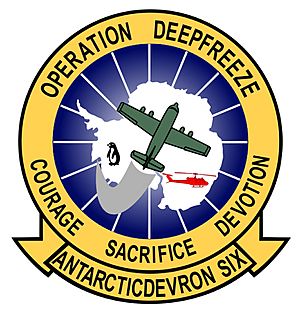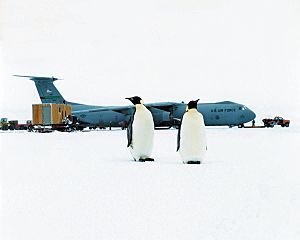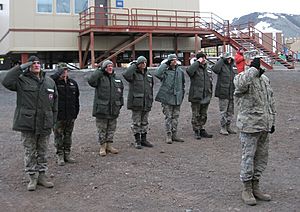Operation Deep Freeze facts for kids
Operation Deep Freeze (often called OpDFrz or ODF) is the name for a series of missions by the United States to Antarctica. These missions started with "Operation Deep Freeze I" in 1955–56. Since then, the U.S. has had a constant presence in Antarctica. "Operation Deep Freeze" now refers to all U.S. operations there. It especially means the regular missions to resupply U.S. bases, which are managed by the U.S. military.
Contents
Early Explorations in Antarctica
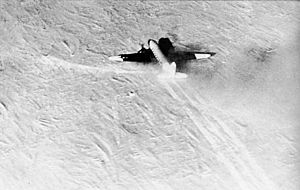
The U.S. Navy had explored Antarctica before. In 1839, Captain Charles Wilkes led the first U.S. Naval expedition into Antarctic waters. Later, in 1929, Admiral Richard E. Byrd set up a naval base called Little America I. He also led an expedition to explore inland and made the first flight over the South Pole.
From 1934 to 1935, Byrd led a second expedition. They explored much more inland and stayed through the winter. His third expedition in 1940 mapped the Ross Sea.
After World War II, Byrd helped with the Navy's Operation Highjump from 1946 to 1947. This mission mapped most of Antarctica's coastline. In 1948, Commander Finn Ronne led an expedition that took air photos of over 450,000 square miles (1.1 million km2). Then, in 1954–55, the icebreaker USS Atka scouted for future landing spots.
Operation Deep Freeze I: A Global Effort
The main reason for Operation Deep Freeze I was the International Geophysical Year (IGY) in 1957–58. The IGY was a big project where forty nations worked together. They studied Earth sciences from the North Pole to the South Pole and everywhere in between.
The United States, along with New Zealand, the United Kingdom, France, Japan, Norway, Chile, Argentina, and the U.S.S.R. agreed to go to the South Pole. This was the least explored area on Earth. Their goal was to learn more about Antarctic water systems, weather patterns, glacier movements, and ocean life.
The U.S. Navy was given the job of supporting the U.S. scientists. Rear Admiral Richard E. Byrd, who had been on four Antarctic expeditions before, was put in charge.
In 1955, Task Force 43 was created to help with the expedition. Rear Admiral George J. Dufek commanded it. Operation Deep Freeze I set up a permanent research station. This paved the way for more detailed research in later Deep Freeze missions. The expedition happened during the Antarctic summer, from November 1955 to April 1956. The U.S. Navy and Walt Disney Studios filmed it. Walt Disney even became an honorary member for designing the Task Force 43 emblem.
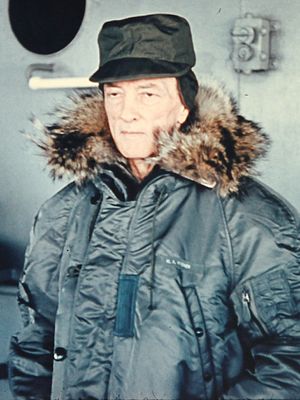

Task Force 43 used several ships, including freighters, icebreakers, and tankers. A special Navy Construction Battalion (Seabees) and several aircraft also helped.
On October 31, 1956, Admiral Dufek and his team successfully landed an R4D Skytrain (Douglas DC-3) aircraft at the South Pole. This was part of the IGY expeditions. It was the first aircraft to land there and the first time Americans had stepped on the South Pole. The plane was named Que Sera, Sera after a popular song. It is now at the National Naval Aviation Museum in Pensacola, Florida.
This landing marked the start of the first permanent base at the South Pole. It was built by airlifts to support the International Geophysical Year. Today, it is known as the Amundsen–Scott South Pole Station. It officially opened on January 1, 1957. The first station, "Old Byrd," lasted about four years before it started to collapse under the snow. A second underground station was built nearby in 1960 and used until 1972. The mission's second base, Byrd Station, was also a research station. It was set up by the U.S. Navy for Operation Deep Freeze II. The airfield built for Operation Deep Freeze was later named Williams Field.
Continuing the Mission
Operation Deep Freeze continued with "Operation Deep Freeze II" and so on. This ensured a constant U.S. presence in Antarctica. The Coast Guard also helped, with USCGC Northwind supporting missions in the 1970s. The Navy's Antarctic Development Squadron Six flew scientific and military missions. The 109th Airlift Wing, with its ski-equipped LC-130s, has been flying support missions for the National Science Foundation since 1988.
In 1996, the U.S. National Guard announced that the 109th Airlift Wing would take over the entire mission from the United States Navy by 1999. This change was made to save money after the Cold War. The 109th Airlift Wing is based in Scotia, New York. The National Science Foundation would fully fund the Antarctic operation.
The idea of the Air National Guard taking over came up in 1988. The 109th Airlift Wing had been supporting radar sites in Greenland. When those sites closed, the unit needed a new main mission. They had been watching the Navy's LC-130 operations in Antarctica. The Navy asked the 109th to provide emergency search and rescue (SAR) help for two years. The Air Guard agreed. They also started helping carry cargo to the South Pole.
The main job of the U.S. Navy and Air National Guard C-130s was to fly fuel and supplies. This was for the National Science Foundation's South Pole Station. These supplies helped personnel survive the long Antarctic winter, which lasts from February to October.
The Air National Guard worked with the Air Staff and the U.S. Navy to plan the change. It was important to convince leaders that keeping air access to both polar regions was vital for the nation.
In 1996, the decision was made to transfer the Operation Deep Freeze mission. All LC-130H aircraft in the U.S. Department of Defense would go to the Air National Guard. The Air National Guard would help the Navy during the 1996–1997 season. Then, the Air National Guard would take command by the end of the 1997–1998 season. The Navy would then help the Air Guard for a year. The planes would fly from Christchurch International Airport in Christchurch, New Zealand, to McMurdo Station, Antarctica. The Air National Guard estimated that this change would save between US$5 million and US$15 million each year.
By 1999, the U.S. Navy had handed over military support for Antarctica. The U.S. Air Force and its contractor, Raytheon Polar Services, took over. Operation Deep Freeze was then managed by the U.S. Air Force and Air National Guard members. Today, operational command belongs to Commander, Thirteenth Air Force.
Current Operations
Civilian and scientific operations in Antarctica are overseen by the United States Antarctic Program and the National Science Foundation. Military support flights happen during the Antarctic summer. This is from late September to early March each year. The 109th Airlift Wing from Scotia, New York, conducts these flights.
The ski-equipped LC-130 Hercules aircraft are key to Operation Deep Freeze. They move cargo to remote locations across the continent. The United States Coast Guard icebreaker USCGC Polar Star, the Air Force Materiel Command, and the Military Sealift Command also provide support. The United States Air Force 13th Air Expeditionary Group deploys to Christchurch, New Zealand, during the operational season.
A documentary about the early missions, Ice Eagles: An Account of American Aviation in Antarctica, was planned for release in 2016.
Lockheed Martin is currently the main contractor for the National Science Foundation's United States Antarctic Program. They started their support operations on April 1, 2012.
See also
 In Spanish: Operación Deep Freeze para niños
In Spanish: Operación Deep Freeze para niños


